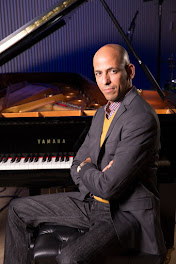Over the past month, I have listened to four different albums featuring vocalist, composer, and activist Magos Herrera. 2018 saw the release of "Dreamers" (Sony Music/Mexico), her brilliant collaboration with Brooklyn Rider while December 2020 was the release date for "Con Alma: An Operatic Tableau on Isolation" (National Sawdust Tracks), Ms. Herrera's album with Italian-born composer Paola Prestini. The newer albums are reviewed below.
For those who don't know Magos Herrera, she's a native of Mexico City who came to the United States in 1992 to study at The Musicians Institute in Los Angeles. She continued her studies in Boston, MA, before returning to Mexico. Her first four albums as a solo artist were recorded in her home city. In 2008, Ms. Herrera moved to New York City and, one year later, released "Distancia" on Sunnyside Records––two years later, she followed up with "México Azul" for the same label. Since then, she was 1/2 of the duo Magos & Limón (Spanish guitarist Javier Limón) that recorded two albums for Sony Music. What stands out for this listener includes her persuasive contralto voice, how she inhabits each song whether she's singing in Spanish, Portuguese, or English, and how she obliterates "borders" in her music (is she a jazz singer, a classical chanteuse, or a folk artist? Yes, all that and more.
"Aire" is her 11th album as a leader, her third for Sunnyside, the first release for that label in 12 years. With her regular working trio of Vinicius Gomes (acoustic guitar), Sam Minaie (bass), and Alex Kautz (drums and percussion) plus guest Ingrid Jensen (trumpet and flugelhorn on two tracks), Dori Caymmi (voice on "Samba em Preludio"), and Gonzalo Grau (percussion on three tracks). The Knights, the 21-member chamber orchestra (see personnel below) also appear on 10 of the 12 tracks playing arrangements by Mr. Grau, by Argentinean pianist Diego Schissi, and the great Brazilian composer and arranger Jaques Morelenbaum ("Samba em Preludio"). The material includes five originals by Ms. Herrera as well as compositions by Chilean folklorist Violetta Parra (1917-1967), by Ariel Ramírez & Félix Luna, by Guinga & César Pinheiro, by Danilo Moraes & Paulo Cesar de Carvahlo, and by Vinicius de Moraes & Baden Powell.
 |
| Photo: Shervin Lainez |
Magos Herrera has created a panacea to the fear and worries of the past few years, music to escape the myriad voices of argument and disagreement of people who use words to hurt and stress their superiority. Can music heal our souls? Ms. Herrera believes so and this magnificent album serves as her proof!
For more information, go to www.magosherrera.com. To hear and to purchase the album, go to https://magosherrera.bandcamp.com/album/aire.
Venezuelan-born pianist and composer Edward Simon first met Magos Herrera in 2017 when he, his trio members (bassist Joe Martin and drummer Adam Cruz) and the vocalist performed together in a 2017 tribute concert honoring the great Argentine vocalist Mercedes Sosa (1935-2009). That planted the seed in the pianist's mind to create a follow-up to his 2016 Sunnyside Records album "Latin American Songbook". This time, Simon with Herrera and the Trio, would focus on Latin American women composers and performers. In addition, the ensemble (with bassist Reuben Rogers replacing Martin and now including and guest percussionist Luis Quintero) worked on a commission that Simon received from the Chamber Music's New Jazz Works––"Latino Soy" is a three-movement piece, two movements featuring lyrics sung and spoken by Ms. Herrera.
Colin and Eric Jacobsen - artistic directors
Wayne du Maine - conductor
Colin Jacobsen, Christina Courtin, Abi Fayette, Alex Fortes, Kristi Hellberg, Nannte Iwata, Yaira Matyakubova - violin
Mario Goto, Celia Hatton - viola
Gabriel Cabezas, Jia Kim - cello
Grey Fulmer - bass
Alex Sopp - flute
Michelle Farah - oboe
Agnes Marchione - clarinet
Edward Burns - bassoon
Karl Kramer-Johansen - horn
Micah Killian - trumpet
Dave Nelson - trombone
Megan Conley - harp
Blair McMillen - piano
license
Listen to "Choro de Lua":
"Femeninas: Songs of Latin American Women" (artistShare) is an 11-song, 63-minute, program that pays tribute to artists such as Joyce Moreno (Brazil), Elizabeth (Chile), Chabuca Granda (Perú), Violetta Parra (Chile), Marta Valdés (Cuba), Rosa Passos (Brazil), and Georgina Hassan (Argentina). Opening with Ms. Moreno's "Feminina", the music jumps out of the speakers on the lively rhythms created by the trio plus the crisp acoustic guitar of Romero Lubambo (one of his two appearances on the album). After Ms. Herrera delivers the lyrics, composed as a question to a Mother as to what "female" means, Rogers takes a delightful, melodic, solo and Quintero adds a short solo. That leads into Ms. Morris's lovely ballad "Décimas"–Simon's arrangement does not stray too far from the original until he pushes the tempo in the second half of the piece. Again, Roger's melodic bass lines stand out not only as foundational but in counterpoint to the vocal.
Other highlights include the stunning "Gracias de la Vida" ("Here's to Life") from the pen of Ms. Parra. After the voice and piano move through the verses, Cruz enters to "converse" with Simon during his solo. Rogers joins them for the final verse of the song. The song then breaks into double-time, a dramatic close to quite a dramatic piece. Lubambo returns for Ms. Passos "Dunas" (lyrics by Fernando de Oliviera), a delicious Bossa Nova with a pleasing solo from Simon.
The program closes with "Hacia Donde" ("where" or "wherever"), a lovely ballad composed by Ms. Valdés (born 1928) for voice and piano. One may not understand Spanish but you cannot miss the pensive mood of the singer and the gentle, "formal", piano in the background that carries that introspective and emotional mood throughout the performance.
When you sit and listen through "Femeninas" several times, you can really hear how the pairing of Magos Herrera and Edward Simon is magic. One feels, actually intuits, that they have worked together for many years. Yet, that's just part of the magic of this project. The rhythm section is powerful, able to "groove" and support in equal measure. Simon's piano work is clear, his phrases articulate, and his arrangements intelligent and respectful. Ms. Herrera's voice is so wondrous, her ability to express emotions and transport listeners beyond the mundane explains why every project she is involved with is worth investigating.
"Femeninas" will be released on June 8, 2023––go to www.edwardsimon.com/projects/femeninas to find out more.
Listen to and watch "Gracias a la Vida":








.jpg)


No comments:
Post a Comment